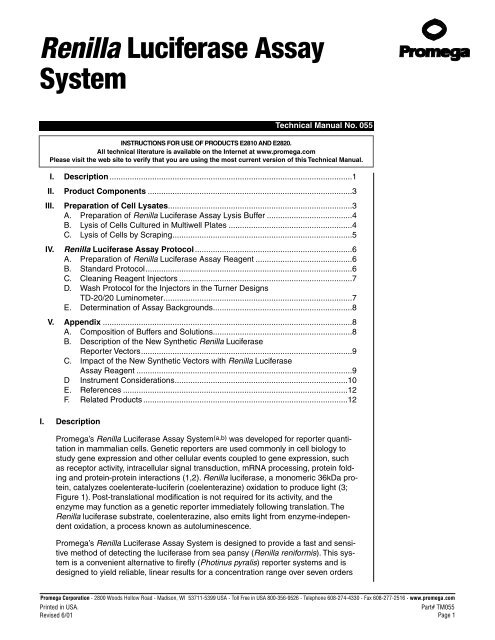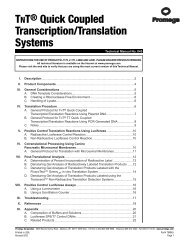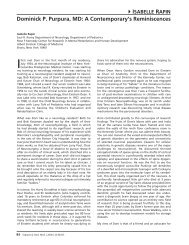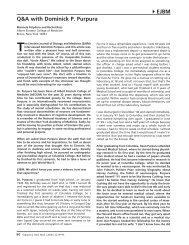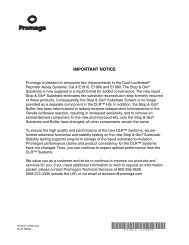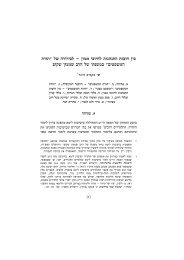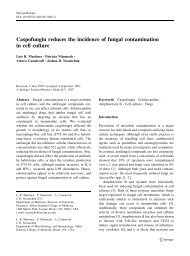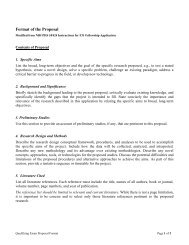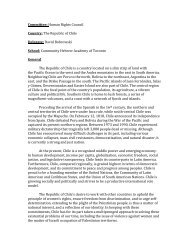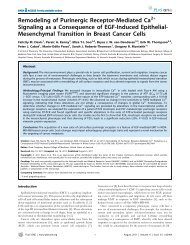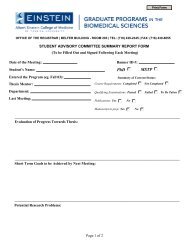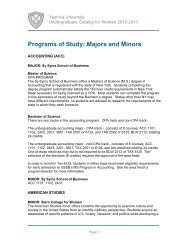Renilla Luciferase Assay System Technical Manual, TM055
Renilla Luciferase Assay System Technical Manual, TM055
Renilla Luciferase Assay System Technical Manual, TM055
Create successful ePaper yourself
Turn your PDF publications into a flip-book with our unique Google optimized e-Paper software.
<strong>Renilla</strong> <strong>Luciferase</strong> <strong>Assay</strong><br />
<strong>System</strong><br />
INSTRUCTIONS FOR USE OF PRODUCTS E2810 AND E2820.<br />
All technical literature is available on the Internet at www.promega.com<br />
Please visit the web site to verify that you are using the most current version of this <strong>Technical</strong> <strong>Manual</strong>.<br />
I. Description ............................................................................................................1<br />
II. Product Components ...........................................................................................3<br />
III. Preparation of Cell Lysates..................................................................................3<br />
A. Preparation of <strong>Renilla</strong> <strong>Luciferase</strong> <strong>Assay</strong> Lysis Buffer ......................................4<br />
B. Lysis of Cells Cultured in Multiwell Plates .......................................................4<br />
C. Lysis of Cells by Scraping................................................................................5<br />
IV. <strong>Renilla</strong> <strong>Luciferase</strong> <strong>Assay</strong> Protocol ......................................................................6<br />
A. Preparation of <strong>Renilla</strong> <strong>Luciferase</strong> <strong>Assay</strong> Reagent ...........................................6<br />
B. Standard Protocol............................................................................................6<br />
C. Cleaning Reagent Injectors .............................................................................7<br />
D. Wash Protocol for the Injectors in the Turner Designs<br />
TD-20/20 Luminometer....................................................................................7<br />
E. Determination of <strong>Assay</strong> Backgrounds..............................................................8<br />
V. Appendix ...............................................................................................................8<br />
A. Composition of Buffers and Solutions..............................................................8<br />
B. Description of the New Synthetic <strong>Renilla</strong> <strong>Luciferase</strong><br />
Reporter Vectors..............................................................................................9<br />
C. Impact of the New Synthetic Vectors with <strong>Renilla</strong> <strong>Luciferase</strong><br />
<strong>Assay</strong> Reagent ................................................................................................9<br />
D Instrument Considerations.............................................................................10<br />
E. References ....................................................................................................12<br />
F. Related Products ...........................................................................................12<br />
I. Description<br />
<strong>Technical</strong> <strong>Manual</strong> No. 055<br />
Promega’s <strong>Renilla</strong> <strong>Luciferase</strong> <strong>Assay</strong> <strong>System</strong> (a,b) was developed for reporter quantitation<br />
in mammalian cells. Genetic reporters are used commonly in cell biology to<br />
study gene expression and other cellular events coupled to gene expression, such<br />
as receptor activity, intracellular signal transduction, mRNA processing, protein folding<br />
and protein-protein interactions (1,2). <strong>Renilla</strong> luciferase, a monomeric 36kDa protein,<br />
catalyzes coelenterate-luciferin (coelenterazine) oxidation to produce light (3;<br />
Figure 1). Post-translational modification is not required for its activity, and the<br />
enzyme may function as a genetic reporter immediately following translation. The<br />
<strong>Renilla</strong> luciferase substrate, coelenterazine, also emits light from enzyme-independent<br />
oxidation, a process known as autoluminescence.<br />
Promega’s <strong>Renilla</strong> <strong>Luciferase</strong> <strong>Assay</strong> <strong>System</strong> is designed to provide a fast and sensitive<br />
method of detecting the luciferase from sea pansy (<strong>Renilla</strong> reniformis). This system<br />
is a convenient alternative to firefly (Photinus pyralis) reporter systems and is<br />
designed to yield reliable, linear results for a concentration range over seven orders<br />
Promega Corporation · 2800 Woods Hollow Road · Madison, WI 53711-5399 USA · Toll Free in USA 800-356-9526 · Telephone 608-274-4330 · Fax 608-277-2516 · www.promega.com<br />
Printed in USA.<br />
Part# <strong>TM055</strong><br />
Revised 6/01 Page 1
of magnitude. The <strong>Renilla</strong> <strong>Luciferase</strong> <strong>Assay</strong> <strong>System</strong> has been formulated with a proprietary<br />
composition that significantly reduces the coelenterazine autoluminescence<br />
commonly seen with other reagents. The result is an assay system that is more sensitive<br />
than published methods by several orders of magnitude (3; Figure 2). This sensitivity<br />
is comparable to that seen with the firefly <strong>Luciferase</strong> <strong>Assay</strong> <strong>System</strong>(c). The<br />
<strong>Renilla</strong> <strong>Luciferase</strong> <strong>Assay</strong> <strong>System</strong> enables measurement of <strong>Renilla</strong> luciferase activity<br />
using either the wildtype or new synthetic <strong>Renilla</strong> luciferase as a primary reporter to<br />
study transcriptional regulation, or as a co-reporter for normalization of experimental<br />
variations such as differences in transfection efficiencies. The <strong>Renilla</strong> <strong>Luciferase</strong><br />
<strong>Assay</strong> <strong>System</strong> consists of <strong>Renilla</strong> <strong>Luciferase</strong> <strong>Assay</strong> Lysis Buffer, <strong>Renilla</strong> <strong>Luciferase</strong><br />
<strong>Assay</strong> Buffer and <strong>Renilla</strong> <strong>Luciferase</strong> <strong>Assay</strong> Substrate. The <strong>Renilla</strong> <strong>Luciferase</strong> <strong>Assay</strong><br />
Reagent and its preparation are described in Section IV.A.<br />
HO<br />
O<br />
N<br />
N<br />
H<br />
N<br />
OH<br />
+O 2<br />
<strong>Renilla</strong><br />
<strong>Luciferase</strong><br />
HO<br />
O<br />
N N<br />
N<br />
OH<br />
+CO 2 + Light<br />
Coelenterazine<br />
Coelenteramide<br />
Figure 1. Bioluminescent reaction catalyzed by <strong>Renilla</strong> luciferase.<br />
1399MC03_1A<br />
Promega Corporation · 2800 Woods Hollow Road · Madison, WI 53711-5399 USA · Toll Free in USA 800-356-9526 · Telephone 608-274-4330 · Fax 608-277-2516 · www.promega.com<br />
Part# <strong>TM055</strong><br />
Page 2<br />
10,000,000<br />
1,000,000<br />
100,000<br />
10,000<br />
1,000<br />
100<br />
10<br />
1<br />
0.1<br />
Luminescence (RLU)<br />
1 × 10 –20<br />
1 × 10 –19<br />
1 × 10 –18<br />
1 × 10 –17<br />
1 × 10 –16<br />
1 × 10 –15<br />
1 × 10 –14<br />
1 × 10 –13<br />
1 × 10 –12<br />
Enzyme Concentration (moles/reaction)<br />
Matthews Buffer (MB)<br />
<strong>Renilla</strong> <strong>Luciferase</strong> <strong>Assay</strong> Reagent (RLAR)<br />
<strong>Luciferase</strong> <strong>Assay</strong> Reagent (LAR)<br />
MB Limit of Detection<br />
RLAR Limit of Detection<br />
LAR Limit of Detection<br />
Figure 2. <strong>Renilla</strong> <strong>Luciferase</strong> <strong>Assay</strong> <strong>System</strong> has comparable sensitivity to the <strong>Luciferase</strong><br />
<strong>Assay</strong> <strong>System</strong> (firefly luciferase) and 100-fold greater sensitivity than a published<br />
method for assaying <strong>Renilla</strong> luciferase. <strong>Renilla</strong> and firefly luciferase luminescence were<br />
compared in <strong>Renilla</strong> <strong>Luciferase</strong> <strong>Assay</strong> Reagent (RLAR) or <strong>Luciferase</strong> <strong>Assay</strong> Reagent (c) (LAR),<br />
respectively, over a titration range of 1 × 10 –12 to 3.56 × 10 –20 moles/reaction. Twenty microliters<br />
of <strong>Renilla</strong> luciferase enzyme was diluted in <strong>Renilla</strong> <strong>Luciferase</strong> <strong>Assay</strong> Lysis Buffer or<br />
Matthews Lysis Buffer (3) and 20µl of firefly luciferase enzyme was diluted in Glo Lysis Buffer<br />
(Cat.# E2661). The diluted <strong>Renilla</strong> luciferase was then added to 100µl of RLAR or Matthews<br />
Buffer, while the diluted firefly luciferase was added to 100µl of LAR. Luminescence was measured<br />
on a Turner Designs Model 20e luminometer. Light emission was integrated over 10 seconds<br />
after an initial 2-second preread delay. Limit of detection values shown represent background<br />
plus two standard deviations and were determined for each assay by performing the<br />
assay without enzyme. Matthews Buffer composition is 0.5M NaCl, 0.1M potassium phosphate,<br />
1.0mM Na 2 EDTA, 1mg/ml porcine gelatin (pH 7.6). 0.1mg/ml porcine gelatin (pH 7.6).<br />
Matthews Lysis Buffer composition is 150mM Hepes (pH 8.0), 0.25% Triton® X-100, 1mg/ml<br />
porcine gelatin; 10% glycerol and 0.05% antifoam 289.<br />
3328MB03_1A<br />
Printed in USA.<br />
Revised 6/01
II.<br />
Product Components<br />
Product Size Cat.#<br />
<strong>Renilla</strong> <strong>Luciferase</strong> <strong>Assay</strong> <strong>System</strong> 100 assays E2810<br />
Each system contains sufficient reagents for 100 standard assays. Includes:<br />
• 100µl <strong>Renilla</strong> <strong>Luciferase</strong> <strong>Assay</strong> Substrate (100X)<br />
• 10ml <strong>Renilla</strong> <strong>Luciferase</strong> <strong>Assay</strong> Buffer<br />
• 30ml <strong>Renilla</strong> <strong>Luciferase</strong> <strong>Assay</strong> Lysis Buffer, 5X<br />
• 1 Protocol<br />
Product Size Cat.#<br />
<strong>Renilla</strong> <strong>Luciferase</strong> <strong>Assay</strong> <strong>System</strong> 1,000 assays E2820<br />
Each system contains sufficient reagents for 1,000 standard assays. Includes:<br />
• 1,000µl <strong>Renilla</strong> <strong>Luciferase</strong> <strong>Assay</strong> Substrate (100X)<br />
• 100ml <strong>Renilla</strong> <strong>Luciferase</strong> <strong>Assay</strong> Buffer<br />
• 30ml <strong>Renilla</strong> <strong>Luciferase</strong> <strong>Assay</strong> Lysis Buffer, 5X<br />
• 1 Protocol<br />
Storage Conditions: Store the <strong>Renilla</strong> <strong>Luciferase</strong> <strong>Assay</strong> <strong>System</strong> at –20°C. <strong>Renilla</strong><br />
<strong>Luciferase</strong> <strong>Assay</strong> Substrate may be stored at –20°C or at –70°C for up to 18 months.<br />
Ideally, <strong>Renilla</strong> <strong>Luciferase</strong> <strong>Assay</strong> Reagent (Substrate + Buffer) should be prepared<br />
fresh for each use. If necessary, the Reagent may be stored at –20°C for 2 weeks or<br />
at –70°C for up to 1 month.<br />
!<br />
<strong>Renilla</strong> <strong>Luciferase</strong><br />
<strong>Assay</strong> Substrate contains<br />
a solvent that can be a<br />
mild irritant. Appropriate<br />
precautions should be<br />
taken to prevent skin and<br />
eye contact. Careful pipeting<br />
of the substrate solvent<br />
is necessary because<br />
of the solvent’s volatile<br />
nature.<br />
III.<br />
Preparation of Cell Lysates<br />
Before performing the <strong>Renilla</strong> <strong>Luciferase</strong> <strong>Assay</strong>, prepare the <strong>Renilla</strong> <strong>Luciferase</strong><br />
<strong>Assay</strong> Lysis Buffer as described in Section III.A, then prepare cell lysates following<br />
one of the procedures explained in Sections III.B or III.C.<br />
Two procedures are described for the preparation of cell lysates using <strong>Renilla</strong><br />
<strong>Luciferase</strong> <strong>Assay</strong> Lysis Buffer. The first procedure is recommended for passive lysis<br />
of cells cultured in multiwell plates (Section III.B). The second procedure is intended<br />
for harvesting cells grown in culture dishes and for cell lysis by scraping of adherent<br />
cells (Section III.C). The <strong>Renilla</strong> luciferase contained in the cell lysates prepared with<br />
<strong>Renilla</strong> <strong>Luciferase</strong> <strong>Assay</strong> Lysis Buffer is stable for 10 hours at room temperature<br />
(22°C) and for up to 24 hours at 4°C. (Stability is defined as ≤10% decrease in<br />
<strong>Renilla</strong> <strong>Luciferase</strong> <strong>Assay</strong> <strong>System</strong> activity.)<br />
Freezing at –20°C is suitable for short-term storage of prepared lysates (up to 1<br />
month). However, we recommend –70°C for long-term storage. Subjecting cell<br />
lysates to more than 5 freeze-thaw cycles may result in gradual loss of <strong>Renilla</strong><br />
luciferase enzyme activity.<br />
Material to Be Supplied by the User<br />
(Solution composition is provided in Section V.A.)<br />
• Phosphate buffered saline (PBS)<br />
Promega Corporation · 2800 Woods Hollow Road · Madison, WI 53711-5399 USA · Toll Free in USA 800-356-9526 · Telephone 608-274-4330 · Fax 608-277-2516 · www.promega.com<br />
Printed in USA.<br />
Part# <strong>TM055</strong><br />
Revised 6/01 Page 3
A. Preparation of <strong>Renilla</strong> <strong>Luciferase</strong> <strong>Assay</strong> Lysis Buffer<br />
<strong>Renilla</strong> <strong>Luciferase</strong> <strong>Assay</strong> Lysis Buffer is supplied as a 5X concentrate. Prepare a<br />
sufficient quantity of the 1X working solution by adding 1 volume of 5X <strong>Renilla</strong><br />
<strong>Luciferase</strong> Lysis Buffer to 4 volumes of distilled water and mixing well. The<br />
diluted (1X) Lysis Buffer may be stored at 4°C for up to one month. However, we<br />
recommend that Lysis Buffer be prepared fresh in the amount needed for each<br />
experiment. Store the 5X <strong>Renilla</strong> <strong>Luciferase</strong> <strong>Assay</strong> Lysis Buffer at –20°C.<br />
!<br />
Use Only<br />
<strong>Renilla</strong> <strong>Luciferase</strong> <strong>Assay</strong><br />
Lysis Buffer with the<br />
<strong>Renilla</strong> <strong>Luciferase</strong> <strong>Assay</strong><br />
<strong>System</strong>. Other lysis buffers<br />
may inhibit the assay.<br />
B. Lysis of Cells Cultured in Multiwell Plates<br />
1. Determine transfection parameters (i.e., plated cell density and subsequent<br />
incubation time) to ensure that cells are no more than 95% confluent at the<br />
desired time of lysate preparation. Remove the growth medium from the cultured<br />
cells, and gently add a sufficient volume of phosphate buffered saline<br />
(PBS) to wash the surface of the culture vessel. Swirl the vessel briefly to<br />
remove detached cells and residual growth medium. Completely remove the<br />
rinse solution before adding <strong>Renilla</strong> <strong>Luciferase</strong> <strong>Assay</strong> Lysis Buffer.<br />
2. To each culture well add the minimum volume of 1X <strong>Renilla</strong> <strong>Luciferase</strong><br />
<strong>Assay</strong> Lysis Buffer required to completely cover the cell monolayer. The recommended<br />
volumes of <strong>Renilla</strong> <strong>Assay</strong> Lysis Buffer to be added per well are<br />
shown in Table 1.<br />
Table 1. Recommended Volumes of 1X <strong>Renilla</strong> <strong>Luciferase</strong> <strong>Assay</strong> Lysis<br />
Buffer for Use in Multiwell Plates.<br />
1X Lysis Buffer<br />
Multiwell Plate Size<br />
Per Well<br />
6 well culture plate 500µl<br />
12 well culture plate 250µl<br />
24 well culture plate 100µl<br />
48 well culture plate 65µl<br />
96 well culture plate 20µl<br />
3. Place the culture plates on a rocking platform or orbital shaker with gentle<br />
rocking/shaking to ensure complete and even coverage of the cell monolayer<br />
with 1X <strong>Renilla</strong> <strong>Luciferase</strong> <strong>Assay</strong> Lysis Buffer. Rock the culture plates<br />
at room temperature for 15 minutes.<br />
4. Transfer the lysate to a tube or vial for further handling and storage.<br />
Alternatively, reporter assays may be performed directly in the wells of the<br />
culture plate. In general, it is unnecessary to clear lysates of residual cell<br />
debris prior to performing the <strong>Renilla</strong> <strong>Luciferase</strong> <strong>Assay</strong>. However, if subsequent<br />
protein determinations are to be performed, we recommend clearing<br />
the lysate samples by centrifugation for 30 seconds at top speed in a<br />
refrigerated microcentrifuge. Alternatively a centrifuge with plate adapters<br />
can be used. Transfer cleared lysates to a fresh tube prior to reporter<br />
enzyme analyses.<br />
Notes:<br />
1. Cultures that are overgrown are often more resistant to complete lysis and<br />
typically require an increased volume of <strong>Renilla</strong> <strong>Luciferase</strong> <strong>Assay</strong> Lysis<br />
Buffer and/or an extended treatment period to ensure complete lysis. <strong>Renilla</strong><br />
Promega Corporation · 2800 Woods Hollow Road · Madison, WI 53711-5399 USA · Toll Free in USA 800-356-9526 · Telephone 608-274-4330 · Fax 608-277-2516 · www.promega.com<br />
Part# <strong>TM055</strong><br />
Page 4<br />
Printed in USA.<br />
Revised 6/01
luciferase is stable in cell lysates prepared with <strong>Renilla</strong> <strong>Luciferase</strong> <strong>Assay</strong><br />
Lysis Buffer, therefore, extending the period of lysis treatment will not<br />
compromise the activity of <strong>Renilla</strong> luciferase.<br />
2. Microscopic inspection of different cell types treated for lysis may reveal<br />
seemingly different lysis results. Treatment of many types of cultured cells<br />
with <strong>Renilla</strong> <strong>Luciferase</strong> <strong>Assay</strong> Lysis Buffer produces complete dissolution of<br />
their structure within a 15-minute period. However, <strong>Renilla</strong> <strong>Luciferase</strong> <strong>Assay</strong><br />
Lysis Buffer treatment of some cell types may result in discernible cell silhouettes<br />
on the surface of the culture well or large accumulations of floating<br />
debris. Despite the appearance of such cell remnants, we typically find complete<br />
solubilization of <strong>Renilla</strong> luciferase within a 15-minute treatment period.<br />
However, some types of cultured cells may exhibit greater inherent resistance<br />
to lysis, and optimizing the treatment conditions may be required.<br />
C. Lysis of Cells by Scraping<br />
1. Remove growth medium from the cultured cells and gently apply a sufficient<br />
volume of PBS to rinse the cells on the bottom of the culture vessel. Swirl<br />
the vessel briefly to remove detached cells and residual growth medium.<br />
Take care to completely remove the rinse solution before adding the 1X<br />
<strong>Renilla</strong> <strong>Luciferase</strong> <strong>Assay</strong> Lysis Buffer.<br />
2. Homogenous lysates may be rapidly prepared by manually scraping the<br />
cells from culture dishes in the presence of 1X <strong>Renilla</strong> <strong>Luciferase</strong> <strong>Assay</strong><br />
Lysis Buffer. The recommended volumes of <strong>Renilla</strong> <strong>Luciferase</strong> <strong>Assay</strong> Lysis<br />
Buffer to be added per culture dish are listed in Table 2.<br />
Table 2. Recommended Volumes of <strong>Renilla</strong> <strong>Luciferase</strong> <strong>Assay</strong> Lysis<br />
Buffer for Use with the Cell Scraping Protocol.<br />
1X Lysis Buffer<br />
Cell Culture Plate Size<br />
Per Well<br />
100 × 20mm 1ml<br />
60 × 15mm 400µl<br />
35 × 12mm 200µl<br />
6 well 250µl<br />
12 well 100µl<br />
!<br />
Use Only<br />
<strong>Renilla</strong> <strong>Luciferase</strong> <strong>Assay</strong><br />
Lysis Buffer with the<br />
<strong>Renilla</strong> <strong>Luciferase</strong> <strong>Assay</strong><br />
<strong>System</strong>. Other lysis buffers<br />
may inhibit the assay.<br />
!<br />
Certain Cell<br />
Types may exhibit greater<br />
inherent resistance to<br />
lysis and optimizing the<br />
treatment conditions may<br />
be required.<br />
3. Cells may be harvested immediately following the addition of <strong>Renilla</strong><br />
<strong>Luciferase</strong> <strong>Assay</strong> Lysis Buffer by scraping with a disposable plastic cell lifter<br />
or a rubber policeman. Tilt the plate, and scrape the lysate down to the<br />
lower edge. Pipet the accumulated lysate several times to obtain a homogenous<br />
suspension. If the scraper is used to prepare more than one sample,<br />
thoroughly clean the scraper between uses.<br />
4. Transfer the lysate into a tube or vial for further handling and storage. The<br />
cell lysate can undergo 1 or 2 freeze-thaw cycles to ensure complete lysis of<br />
cells. Generally, it is unnecessary to clear lysates of residual cell debris prior<br />
to performing the <strong>Renilla</strong> <strong>Luciferase</strong> <strong>Assay</strong>. However, if subsequent protein<br />
determinations are to be performed, we recommend clearing the lysate<br />
samples by centrifugation for 30 seconds in a refrigerated microcentrifuge.<br />
5. Transfer the cleared lysates to a fresh tube prior to reporter enzyme<br />
analyses.<br />
Promega Corporation · 2800 Woods Hollow Road · Madison, WI 53711-5399 USA · Toll Free in USA 800-356-9526 · Telephone 608-274-4330 · Fax 608-277-2516 · www.promega.com<br />
Printed in USA.<br />
Part# <strong>TM055</strong><br />
Revised 6/01 Page 5
IV.<br />
<strong>Renilla</strong> <strong>Luciferase</strong> <strong>Assay</strong> Protocol<br />
A. Preparation of <strong>Renilla</strong> <strong>Luciferase</strong> <strong>Assay</strong> Reagent<br />
!<br />
<strong>Renilla</strong><br />
<strong>Luciferase</strong> <strong>Assay</strong><br />
Substrate contains a solvent<br />
that may be a mild<br />
irritant. Appropriate precautions<br />
should be taken<br />
to prevent skin and eye<br />
contact. Careful pipeting<br />
of the solvent is necessary<br />
because of the<br />
solvent’s volatile nature.<br />
Materials to Be Supplied by the User<br />
• luminometer<br />
• siliconized polypropylene tube or small glass vial<br />
1. <strong>Renilla</strong> <strong>Luciferase</strong> <strong>Assay</strong> Reagent (Substrate + Buffer) is best when prepared<br />
fresh. It is stable for 12 hours at room temperature. If necessary,<br />
<strong>Renilla</strong> <strong>Luciferase</strong> <strong>Assay</strong> Reagent may be stored at –20°C for 2 weeks or at<br />
–70°C for up to 1 month. It may be thawed at room temperature up to five<br />
times without appreciable activity loss. Note: Stability is defined as ≤10%<br />
decrease in <strong>Renilla</strong> <strong>Luciferase</strong> <strong>Assay</strong> <strong>System</strong> activity.<br />
2. Prepare an adequate volume to perform the desired number of <strong>Renilla</strong><br />
<strong>Luciferase</strong> <strong>Assay</strong>s (100µl reagent per assay). Add 1 volume of 100X <strong>Renilla</strong><br />
<strong>Luciferase</strong> Substrate to 100 volumes of <strong>Renilla</strong> <strong>Luciferase</strong> <strong>Assay</strong> Buffer in a<br />
glass or siliconized polypropylene tube. If the entire volume of <strong>Renilla</strong><br />
<strong>Luciferase</strong> <strong>Assay</strong> Buffer is to be made into <strong>Renilla</strong> <strong>Luciferase</strong> <strong>Assay</strong><br />
Reagent, the <strong>Renilla</strong> <strong>Luciferase</strong> <strong>Assay</strong> Buffer Bottle may be used.<br />
Example 1 (10 assays)<br />
Add 10µl of 100X <strong>Renilla</strong> <strong>Luciferase</strong> <strong>Assay</strong> Substrate to 1ml of <strong>Renilla</strong><br />
<strong>Luciferase</strong> <strong>Assay</strong> Buffer contained in either a glass vial or siliconized<br />
polypropylene tube. This will prepare sufficient <strong>Renilla</strong> <strong>Luciferase</strong> <strong>Assay</strong><br />
Reagent to perform 10 assays.<br />
Example 2 (100 assays)<br />
Transfer 10ml <strong>Renilla</strong> <strong>Luciferase</strong> <strong>Assay</strong> Buffer into a glass vial or siliconized<br />
polypropylene tube or measure 10ml of <strong>Renilla</strong> <strong>Luciferase</strong> <strong>Assay</strong> Buffer in a<br />
10ml pipette, discard the residual buffer in the bottle and return the 10ml of<br />
<strong>Renilla</strong> <strong>Luciferase</strong> <strong>Assay</strong> Buffer to the bottle. Add 100µl of 100X <strong>Renilla</strong><br />
<strong>Luciferase</strong> <strong>Assay</strong> Substrate (RLAS) to the 10ml <strong>Renilla</strong> <strong>Luciferase</strong> <strong>Assay</strong><br />
Buffer. Rinse the pipette tip used to transfer the RLAS in the newly prepared<br />
Reagent to wash any residual substrate from the pipette tip.<br />
B. Standard Protocol<br />
!<br />
Prior To<br />
Beginning this protocol,<br />
verify that the <strong>Renilla</strong><br />
<strong>Luciferase</strong> <strong>Assay</strong> Reagent<br />
has been prepared fresh<br />
or has been thawed in a<br />
room temperature water<br />
bath and mixed prior to<br />
use, as thawing generates<br />
density and composition<br />
gradients.<br />
The following protocol is designed for use with manual luminometers, or other<br />
luminometers fitted with one reagent injector.<br />
If using a manual luminometer:<br />
1. Add 100µl of <strong>Renilla</strong> <strong>Luciferase</strong> <strong>Assay</strong> Reagent to the luminometer tube.<br />
2. Add 20µl of cell lysate. Mix quickly by flicking the tube with a finger or vortex<br />
to thoroughly mix (1–2 seconds).<br />
3. Place tube in luminometer and initiate measurement. Luminescence is normally<br />
integrated over 10 seconds with a 2-second delay. Other integration<br />
times may also be used.<br />
4. If the luminometer is not connected to a printer or computer, record the<br />
<strong>Renilla</strong> luciferase activity measurement.<br />
5. Discard the reaction tube, and proceed to the next <strong>Renilla</strong> <strong>Luciferase</strong> <strong>Assay</strong><br />
reaction, repeating Steps 1–4.<br />
Promega Corporation · 2800 Woods Hollow Road · Madison, WI 53711-5399 USA · Toll Free in USA 800-356-9526 · Telephone 608-274-4330 · Fax 608-277-2516 · www.promega.com<br />
Part# <strong>TM055</strong><br />
Page 6<br />
Printed in USA.<br />
Revised 6/01
If using a luminometer fitted with one reagent injector:<br />
1. Format the luminometer so that the injector dispenses 100µl. Prime the<br />
injector with <strong>Renilla</strong> <strong>Luciferase</strong> <strong>Assay</strong> Reagent.<br />
2. For each reaction, carefully add 20µl of cell lysate to an individual luminometer<br />
tube or to the wells of a multiwell plate.<br />
3. Place the samples in a luminometer.<br />
4. Initiate measurement. This action will cause <strong>Renilla</strong> <strong>Luciferase</strong> <strong>Assay</strong><br />
Reagent to be injected into the reaction vessel and the measurement to be<br />
subsequently taken. Luminescence is normally integrated over 10 seconds<br />
with a 2-second delay. Other integration times may also be used.<br />
5. If the luminometer is not connected to a printer or computer, record the<br />
<strong>Renilla</strong> luciferase activity measurement.<br />
6. If using a single tube luminometer, discard the reaction tube, and proceed to<br />
the next <strong>Renilla</strong> <strong>Luciferase</strong> <strong>Assay</strong> reaction. If using a plate luminometer, the<br />
luminometer will automatically begin injecting <strong>Renilla</strong> <strong>Luciferase</strong> <strong>Assay</strong><br />
Reagent into the next well indicated on the luminometer plate.<br />
C. Cleaning Reagent Injectors<br />
1. Purge <strong>Renilla</strong> <strong>Luciferase</strong> <strong>Assay</strong> Reagent from the injector lines by repeated<br />
priming/washing with a volume of deionized water equivalent to 3 pump void<br />
volumes.<br />
2. Prepare 70% ethanol in water as wash reagent. Prime the system with at<br />
least 5ml of 70% ethanol to completely replace the void volume and rinse<br />
the injector plumbing. It is preferable to allow the injector to soak in this<br />
wash solution for 30 minutes prior to rinsing with deionized water.<br />
3. Rinse with a volume of deionized water equivalent to at least 3 pump void<br />
volumes to thoroughly remove all traces of ethanol.<br />
!<br />
Priming <strong>Assay</strong><br />
Reagent through an<br />
empty injector system<br />
prevents dilution and contamination<br />
of the primed<br />
reagent.<br />
Note: To prime auto-injector<br />
systems with little or no<br />
loss of <strong>Renilla</strong> <strong>Luciferase</strong><br />
<strong>Assay</strong> Reagent we recommend<br />
first purging all storage<br />
liquid (i.e., deionized<br />
water or ethanol wash<br />
solution; Section IV.C)<br />
from the injector system.<br />
Priming assay reagent<br />
through an empty injector<br />
system prevents dilution<br />
and contamination of the<br />
primed reagent. Thus, the<br />
volume of primed reagent<br />
may be recovered and<br />
returned to the reservoir<br />
of bulk reagent.<br />
D. Wash Protocol for the Injectors in the Turner Designs TD-20/20<br />
Luminometer<br />
1. Rinse the <strong>Renilla</strong> <strong>Luciferase</strong> <strong>Assay</strong> Reagent from the injector by performing<br />
10 priming cycles with deionized water.<br />
2. Perform at least 10 priming cycles with 70% ethanol and allow tubing to<br />
soak in this wash solution for 30 minutes.<br />
3. Perform at least 10 priming cycles with deionized water to remove all traces<br />
of ethanol.<br />
Promega Corporation · 2800 Woods Hollow Road · Madison, WI 53711-5399 USA · Toll Free in USA 800-356-9526 · Telephone 608-274-4330 · Fax 608-277-2516 · www.promega.com<br />
Printed in USA.<br />
Part# <strong>TM055</strong><br />
Revised 6/01 Page 7
E. Determination of <strong>Assay</strong> Backgrounds<br />
The expression of a luciferase reporter is quantitated as the luminescence produced<br />
above background levels. In most cases, because the background created<br />
by the reagent in the absence of <strong>Renilla</strong> luciferase is exceptionally low, this<br />
luciferase activity is directly proportional to total luminescence. However, when<br />
measuring very small amounts of luciferase it is important to subtract the background<br />
signal from the measurement of total luminescence. Background luminescence<br />
in the measurement of <strong>Renilla</strong> luciferase activity can arise from two<br />
possible sources:<br />
• Instrument and sample tube background luminescence.<br />
!<br />
Five to Ten<br />
background readings<br />
should be performed, and<br />
the mean reading used to<br />
obtain a statistically significant<br />
value for instrument<br />
and sample tube<br />
background.<br />
• Autoluminescence of the <strong>Renilla</strong> luciferase substrate, coelenterazine. This<br />
is caused by nonenzymatic oxidation of the coelenterazine in solution.<br />
The background luminescence contributed by the sources noted above is consistent<br />
throughout the experiment and can be subtracted from subsequent measurements<br />
of <strong>Renilla</strong> luciferase. To determine the background contributed by the<br />
instrument, the sample tube and coelenterazine autoluminescence, follow this<br />
procedure:<br />
1. Use <strong>Renilla</strong> <strong>Luciferase</strong> <strong>Assay</strong> Lysis Buffer to prepare a lysate of nontransfected<br />
control (NTC) cells.<br />
2. Perform the <strong>Renilla</strong> <strong>Luciferase</strong> <strong>Assay</strong> as for experimental samples (Section<br />
IV.B).<br />
3. Measure the luminescence (this is the background luminescence).<br />
4. Subtract the background luminescence as determined in Step 3 from the<br />
experimental sample luminescence.<br />
V. Appendix<br />
A. Composition of Buffers and Solutions<br />
Phosphate Buffered Saline (PBS, 10X)<br />
11.5g Na 2 HPO 4<br />
2g KH 2 PO 4<br />
80g NaCl<br />
2g KCl<br />
Dissolve in 1 liter of sterile, deionized water.<br />
The pH of 1X PBS will be 7.4.<br />
Promega Corporation · 2800 Woods Hollow Road · Madison, WI 53711-5399 USA · Toll Free in USA 800-356-9526 · Telephone 608-274-4330 · Fax 608-277-2516 · www.promega.com<br />
Part# <strong>TM055</strong><br />
Page 8<br />
Printed in USA.<br />
Revised 6/01
B. Description of the New Synthetic <strong>Renilla</strong> <strong>Luciferase</strong> Reporter Vectors<br />
The second generation of <strong>Renilla</strong> control vectors consists of seven vectors in<br />
which a synthetic <strong>Renilla</strong> luciferase gene sequence has been inserted for more<br />
efficient mammalian expression and reduced risk of anomalous transcriptional<br />
behavior. The <strong>Renilla</strong> gene has been redesigned by a systematic approach in<br />
which codons have been changed to those most frequently used in mammals,<br />
while simultaneously removing most of the consensus sequences of the transcription<br />
factor binding sites. The new DNA sequence changed the second<br />
amino acid of the protein from Thr in the wildtype to Ala, introducing a Kozak<br />
sequence that may result in better expression efficiency. The potential transcription<br />
factor binding sites are reduced from around 300 in the native gene to only<br />
a few in the synthetic <strong>Renilla</strong> luciferase gene. This new synthetic <strong>Renilla</strong><br />
luciferase gene is cloned into a variety of expression vector backbones to<br />
provide a series of vectors to fit various experimental conditions.<br />
The second generation of <strong>Renilla</strong> control vectors provide significant advantages<br />
over the prior pRL <strong>Renilla</strong> control vectors:<br />
• Improved expression levels: The new synthetic <strong>Renilla</strong> luciferase gene<br />
supports a significant increase in <strong>Renilla</strong> luciferase expression in mammalian<br />
cells. Depending on the vector and cell line used, up to a 300-fold<br />
increase in expression may be obtained.<br />
• Improved reliability of the control reporter: The new synthetic <strong>Renilla</strong><br />
luciferase gene exhibits reduced risk of anomalous transcriptional behavior,<br />
and the co-reporter expression is less likely to be influenced by experimental<br />
treatments.<br />
• Different promoter and vector backbones: A variety of configurations are<br />
available to support both adequate expression and reliability of the control<br />
reporter under different experimental conditions.<br />
• Vectors are purified to the extent that they may be used directly in<br />
transfection without the need for further manipulation.<br />
C. Impact of the New Synthetic Vectors with <strong>Renilla</strong> <strong>Luciferase</strong> <strong>Assay</strong><br />
Reagent<br />
Depending on the vector backbone and the cell line used in an experiment, up to<br />
a 300-fold increase in activity can be detected when using the synthetic <strong>Renilla</strong><br />
gene, compared to results determined with the native gene found in the previous<br />
generation of pRL Vectors. Sensitivity is further enhanced by the improvements<br />
found in <strong>Renilla</strong> <strong>Luciferase</strong> <strong>Assay</strong> <strong>System</strong> compared to other methods (i.e.,<br />
Matthews Buffer; Figure 3). The <strong>Renilla</strong> <strong>Luciferase</strong> <strong>Assay</strong> Reagent combined<br />
with the new synthetic vectors creates opportunities for the most robust, highly<br />
sensitive reporter assay system available.<br />
Promega Corporation · 2800 Woods Hollow Road · Madison, WI 53711-5399 USA · Toll Free in USA 800-356-9526 · Telephone 608-274-4330 · Fax 608-277-2516 · www.promega.com<br />
Printed in USA.<br />
Part# <strong>TM055</strong><br />
Revised 6/01 Page 9
10,000<br />
1,000<br />
Native<br />
Synthetic<br />
Signal-to-Noise<br />
100<br />
10<br />
1<br />
0.1<br />
0.01<br />
Matthews Buffer<br />
<strong>Assay</strong><br />
<strong>Renilla</strong> <strong>Luciferase</strong><br />
<strong>Assay</strong><br />
3329MA03_1A<br />
Figure 3. The <strong>Renilla</strong> <strong>Luciferase</strong> <strong>Assay</strong> <strong>System</strong> was used to measure expression from<br />
Promega’s first generation of <strong>Renilla</strong> vectors containing the native <strong>Renilla</strong> gene and<br />
from the new phRL Vectors (b) containing the synthetic <strong>Renilla</strong> gene. <strong>Renilla</strong> luciferase,<br />
expressed in CHO cells transfected with either the pRL-TK(Int – ) (native gene) or the phRL-<br />
TK(Int – ) (b) (new synthetic gene), was measured using either <strong>Renilla</strong> <strong>Luciferase</strong> <strong>Assay</strong><br />
Reagent or Matthews Buffer (3; compositions as noted in Figure 2) as follows. CHO cells containing<br />
<strong>Renilla</strong> luciferase were lysed in <strong>Renilla</strong> <strong>Luciferase</strong> <strong>Assay</strong> Lysis Buffer or Matthews<br />
Lysis Buffer. Twenty microliter aliquots of lysate containing the native or synthetic gene were<br />
added to 100µl of <strong>Renilla</strong> <strong>Luciferase</strong> <strong>Assay</strong> Reagent or Matthews Buffer. Luminescence was<br />
measured on a Turner Designs Model 20e luminometer. Light emission was integrated over a<br />
10-second read after an initial 2-second preread delay. Transfection efficiencies for each set of<br />
vectors were normalized to firefly enzyme, which was co-transfected in the same cells. Firefly<br />
luciferase was measured with <strong>Luciferase</strong> <strong>Assay</strong> Reagent (LAR) from Promega.<br />
D. Instrument Considerations<br />
Single-Sample Luminometers<br />
The <strong>Renilla</strong> <strong>Luciferase</strong> <strong>Assay</strong> Reagent exhibits reaction kinetics in which the signal<br />
half-life is at least 2 minutes (Figure 4). Thus, single-sample luminometers<br />
designed for low-throughput applications do not require reagent injectors to perform<br />
<strong>Renilla</strong> luciferase assays. Luminometers should be configured to measure<br />
light emission over a defined period, rather than measuring “flash” intensity or<br />
“peak” height. For the standard <strong>Renilla</strong> <strong>Luciferase</strong> <strong>Assay</strong>, we recommend programming<br />
luminometers to provide a 2-second preread delay, followed by a 10-<br />
second measurement period. However, depending on the type of instrument and<br />
the number of samples being processed, some users may prefer to shorten the<br />
period of premeasurement delay and/or the period of luminescence measurement.<br />
For convenience, one can equip the luminometers with a computer or an<br />
online printer for direct capture of data output, eliminating the need to pause<br />
between samples to manually record the measured values.<br />
The Turner Designs Model TD-20/20 Luminometer, equipped with single or dual<br />
auto-injector systems (Promega Cat.# E2351 or E2061) and printer, is ideally<br />
suited for low-throughput processing of <strong>Renilla</strong> luciferase assays. The TD-20/20<br />
Luminometer is preprogrammed to perform injections and readings of <strong>Renilla</strong><br />
luciferase reporter activity with a single “Start” command. Furthermore, the<br />
instrument is programmed to provide individual luminescence measurements, as<br />
well as statistical analyses of values measured within replicate groups.<br />
Promega Corporation · 2800 Woods Hollow Road · Madison, WI 53711-5399 USA · Toll Free in USA 800-356-9526 · Telephone 608-274-4330 · Fax 608-277-2516 · www.promega.com<br />
Part# <strong>TM055</strong><br />
Page 10<br />
Printed in USA.<br />
Revised 6/01
120<br />
Relative Luminescence (%)<br />
100<br />
80<br />
60<br />
40<br />
20<br />
0<br />
0 2 4 6 8 10<br />
Time (seconds)<br />
3355MA04_1A<br />
Figure 4. Signal profile collected over ten seconds shows signal stability. Purified<br />
<strong>Renilla</strong> enzyme was diluted in <strong>Renilla</strong> <strong>Luciferase</strong> <strong>Assay</strong> Reagent. A 20µl aliquot of enzyme<br />
was mixed with 100µl of <strong>Renilla</strong> <strong>Luciferase</strong> <strong>Assay</strong> Reagent and <strong>Renilla</strong> luciferase activity was<br />
measured immediately. Although data was collected using a continuous-read luminometer<br />
(the Orion Berthold Detection <strong>System</strong>, a 96-well plate luminometer), the same data can be<br />
achieved using a Turner Designs Model 20e luminometer with a 2-second pre-integration<br />
delay.<br />
Multiple Sample and Plate-Reading Luminometers<br />
The most convenient method of performing large numbers of <strong>Renilla</strong> <strong>Luciferase</strong><br />
<strong>Assay</strong> measurements is to use a luminometer capable of processing multiple<br />
sample tubes or by configuring assays in a 96 well plate and using a plate-reading<br />
luminometer.<br />
For high-throughput applications, we recommend first dispensing the desired<br />
volume of each sample into the individual assay tubes or wells of the microplate.<br />
<strong>Renilla</strong> luciferase assays are then performed according to the following steps:<br />
i) inject <strong>Renilla</strong> <strong>Luciferase</strong> <strong>Assay</strong> Reagent and; ii) measure luminescence from<br />
<strong>Renilla</strong> luciferase. Therefore, multisample and plate-reading luminometers<br />
should be equipped with at least one reagent injector to perform the <strong>Renilla</strong><br />
<strong>Luciferase</strong> <strong>Assay</strong>.<br />
Note: It is common for the luminescence intensity of luciferase-mediated reactions<br />
to exceed the linear range of a luminometer. Verify that your luminometer<br />
provides a diagnostic warning when the luminescence of a given sample<br />
exceeds the linear range of the photomultiplier tube. If it does not, it is important<br />
to establish the luminometer’s linear range of detection prior to performing<br />
<strong>Renilla</strong> luciferase reporter assays. Purified <strong>Renilla</strong> luciferase or <strong>Renilla</strong> luciferase<br />
expressed in cell lysates may be used to determine the working range of a particular<br />
luminometer. Perform serial dilutions of purified <strong>Renilla</strong> luciferase in<br />
1X <strong>Renilla</strong> <strong>Luciferase</strong> <strong>Assay</strong> Lysis Buffer containing 1mg/ml of porcine gelatin.<br />
Gelatin may be omitted if cell lysates are used. The addition of exogenous protein<br />
can help to ensure stability of the purified <strong>Renilla</strong> luciferase enzyme at<br />
extremely dilute concentrations. However, all purified enzyme dilutions should be<br />
used within three hours of their preparation to ensure optimal performance.<br />
Promega Corporation · 2800 Woods Hollow Road · Madison, WI 53711-5399 USA · Toll Free in USA 800-356-9526 · Telephone 608-274-4330 · Fax 608-277-2516 · www.promega.com<br />
Printed in USA.<br />
Part# <strong>TM055</strong><br />
Revised 6/01 Page 11
E. References<br />
1. Wood, K.V. et al. (1984) Synthesis of active firefly luciferase by in vitro translation<br />
of RNA obtained from adult lanterns. Biochem. Biophys. Res. Comm.<br />
124, 592–6.<br />
2. de Wet, J.R. et al. (1985) Cloning of firefly luciferase cDNA and the expression<br />
of active luciferase in Escherichia coli. Proc. Natl. Acad. Sci. USA 82,<br />
7870–3.<br />
3. Matthews, J.C., Hori, K. and Cormier, M.J. (1977) Purification and properties<br />
of <strong>Renilla</strong> reniformis luciferase. Biochemistry 16, 85–91.<br />
F. Related Products<br />
Synthetic <strong>Renilla</strong> <strong>Luciferase</strong> Reporter Vectors<br />
Product Size Cat.#<br />
phRL-null Vector (b,d,j) 20µg E6231<br />
phRL-TK Vector (b,d,j) 20µg E6241<br />
phRL-TK(Int–) Vector(b,d,j) 20µg E6251<br />
phRL-SV40 Vector (b,d,j) 20µg E6261<br />
phRL-CMV Vector (b,d,e,j) 20µg E6271<br />
phRG-B Vector(b,d,j) 20µg E6281<br />
phRG-TK Vector (b,d,j) 20µg E6291<br />
<strong>Luciferase</strong> Reporter Vector Sequencing Primers<br />
Product Size Cat.#<br />
RVprimer3 (counter clockwise) 2µg E4481<br />
RVprimer4 (clockwise) 2µg E4491<br />
<strong>Luciferase</strong> <strong>Assay</strong> <strong>System</strong>s<br />
Product Size Cat.#<br />
Dual-<strong>Luciferase</strong>® Reporter <strong>Assay</strong> <strong>System</strong>(c,f) 100 assays E1910<br />
Dual-<strong>Luciferase</strong> ® Reporter <strong>Assay</strong> <strong>System</strong> 10 pack (c,f) 1,000 assays E1960<br />
Dual-<strong>Luciferase</strong> ® Reporter 1000 <strong>Assay</strong> <strong>System</strong> (c,f) 1,000 assays E1980<br />
Transfection <strong>System</strong>s<br />
Product Size Cat.#<br />
TransFast Transfection Reagents (g) 1.2mg E2431<br />
Transfectam® Reagent for the Transfection of Eukaryotic Cells(h) 1mg E1231<br />
0.5mg E1232<br />
Tfx-50 Reagent (i) 2.1mg E1811<br />
Tfx-20 Reagent(i) 4.8mg E2391<br />
Tfx-10 Reagent (i) 9.3mg E2381<br />
Tfx Reagents Transfection Trio(i) 5.4mg E2400<br />
ProFection ® Mammalian Transfection <strong>System</strong> -<br />
Calcium Phosphate 80 transfections E1200<br />
ProFection ® Mammalian Transfection <strong>System</strong> -<br />
DEAE-Dextran 80 transfections E1210<br />
Promega Corporation · 2800 Woods Hollow Road · Madison, WI 53711-5399 USA · Toll Free in USA 800-356-9526 · Telephone 608-274-4330 · Fax 608-277-2516 · www.promega.com<br />
Part# <strong>TM055</strong><br />
Page 12<br />
Printed in USA.<br />
Revised 6/01
Luminometers<br />
Product<br />
Turner Designs Model TD-20/20 Luminometer<br />
Turner Designs Model TD-20/20 Luminometer with Printer<br />
Turner Designs Model TD-20/20 Luminometer with Single Auto Injector<br />
Turner Designs Model TD-20/20 Luminometer with Dual Auto Injector<br />
Turner Designs Model TD-20/20 Luminometer with Printer<br />
and Dual Auto Injector<br />
Cat.#<br />
E2041<br />
E2051<br />
E2351<br />
E2361<br />
E2061<br />
(a) Patent Pending.<br />
(b) Certain applications of this product may require licenses from others.<br />
(c) U.S. Pat. No. 5,283,179, 5,641,641, 5,650,289, 5,814,471, Australian Pat. No. 649289 and European Pat. No. 0 553 234 have been issued to<br />
Promega Corporation for a firefly luciferase assay method, which affords greater light output with improved kinetics as compared to the conventional<br />
assay. Other patents are pending.<br />
(d) Licensed under U.S. Pat. Nos. 5,292,658, 5,418,155 and other patents.<br />
(e) The CMV promoter and its use are covered under U.S. Pat. Nos. 5,168,062 and 5,385,839 owned by the University of Iowa Research<br />
Foundation, Iowa City, Iowa, and licensed FOR RESEARCH USE ONLY. Commercial users must obtain a license to these patents directly from<br />
the University of Iowa Research Foundation.<br />
(f) U.S. Pat. No. 5,744,320 and Australian Pat. No. 721172 have been issued to Promega Corporation for quenching reagents and assays for<br />
enzyme-mediated luminescence. Other patents are pending.<br />
(g) The cationic lipid component of the TransFast Transfection Reagent is covered by U.S. Pat. Nos. 5,824,812, 5,869, 715 and pending foreign<br />
patents.<br />
(h) Transfectam is a registered trademark of BioSepra, S.A., the holder of a license from CNRS-ULP Strasbourg under U.S. Pat. No. 5,171,678 to<br />
sell the Transfectam ® product for research purposes only. The Transfectam ® product was developed by J.P. Behr and J.P. Loeffler and is covered<br />
by the aforementioned patent.<br />
(i) The cationic lipid component of the Tfx Reagents is covered by U.S. Pat. Nos. 5,527,928, 5,744,625 and 5,892,071, Australian Pat. No.<br />
704189 and other pending foreign patents.<br />
(j) Organizations may use this product in their research and they may transfer derivatives of the product to colleagues at other Nonprofit<br />
Organizations provided that such colleagues agree in writing to be bound by the terms and conditions of this label license. Researchers may<br />
not transfer this product or its derivatives to researchers at other organizations, which are not Nonprofit Organizations, without the express written<br />
consent of Promega and without those entities having an express license from Promega for the use of the product. Other than as specifically<br />
provided here, an authorized transferee of this product shall have no right to transfer this product or its derivatives to any other person or<br />
entity. A Nonprofit Organization means (1) a university or other institution of higher education located in any country; (2) an organization of the<br />
type described in section 501(c)(3) of the Internal Revenue Code of 1954 [26 U.S.C. 501(c)(3)] and exempt from taxation under section 501(a)<br />
of the Internal Revenue Code [26 U.S.C. 501(a)]; or (3) any nonprofit organization located in a foreign country that would qualify as a nonprofit<br />
organization under paragraph (2) of this section if it were located in the United States. Any organization that is not "Nonprofit" as defined here is<br />
considered a for-profit organization. A Nonprofit Organization performing research for a for-profit organization also shall be considered for-profit.<br />
With respect to research use by for-profit organizations, or any diagnostic or therapeutic uses, please contact Promega Corporation for supply<br />
and licensing information.<br />
© 2001 Promega Corporation. All Rights Reserved.<br />
Dual-<strong>Luciferase</strong> and ProFection are trademarks of Promega Corporation and are registered with the U.S. Patent and Trademark Office. Tfx and<br />
TransFast are trademarks of Promega Corporation.<br />
Triton is a registered trademark of Union Carbide Chemicals and Plastics Co., Inc.<br />
All prices and specifications are subject to change without prior notice.<br />
Product claims are subject to change. Please contact Promega <strong>Technical</strong> Services or access the Promega online catalog for the most up-todate<br />
information on Promega products.<br />
Promega Corporation · 2800 Woods Hollow Road · Madison, WI 53711-5399 USA · Toll Free in USA 800-356-9526 · Telephone 608-274-4330 · Fax 608-277-2516 · www.promega.com<br />
Printed in USA.<br />
Part# <strong>TM055</strong><br />
Revised 6/01 Page 13


